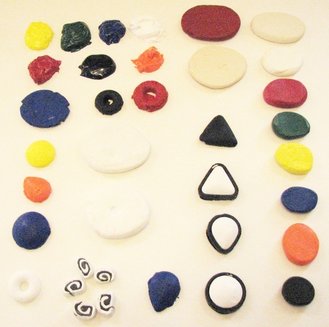
This post is a general explanation of what polymer clay is and how it is made and is not intended to be a tutorial on the chemistry of plastisols. But it does provide a background for understanding the commercial products and includes the shortcut that I have discovered that will allow you to make "real" polymer clay at home in a very cost effective manner. The video should be considered a "proof of concept" as there is still a lot to do and explore. I offer the work in good faith in the hope that there will be readers/viewers who will help move the project forward.
Polymer clay as both a craft and an art form seems to be one of the most popular activities for home enthusiasts who enjoy making unique and frequently useful jewelry, figurines, and other personally individual items for fun and profit. But, polymer clay is not a clay! It is a polymer and more specifically it is a plastisol which is a polymer with a plasticizer. In the majority of commercially available products, the polymer is polyvinyl chloride in powder form (PVC), and the plasticizer, typically a thick viscous liquid with a boiling point above 200 C. The plasticizer can be any of several materials that are considered generally safe. But, all of the products sold as polymer clay are proprietary and closely guarded secrets. In addition to the two basic ingredients they have to add thickeners, fillers, color pigments, and other materials to make the polymer into a putty like consistency for effective model making.
Polymer clay remains workable until cured. Curing occurs at temperatures from between 265 °F (129 °C) to 275 °F (135 °C) sustained for 15 minutes per 1⁄4 inch (6.4 mm) of thickness. This temperature is significantly less than for mineral clays that are fired at high temperatures and can be achieved using a home oven. The clay does not shrink when cured. Brands of polymer clay include Fimo, Sculpy, Premo, Cernit, Formello, Modello, Du-Kit, Pardo and Kato Polyclay.
A home pasta-making machine is a popular multi-purpose tool for polymer clay artists. It is used to create sheets of uniform thickness, to mix colors or construct variegated sheets, and to condition (soften) the clay. Polymer clay generally needs to be conditioned prior to use. This involves kneading the clay by hand, passing it between two rollers, or using a low-shear mixer to break up any resin particle adhesion. Once conditioned, the clay will remain pliable until the particles eventually re-adhere.
How this project evolved:
Plastisols have been around for many years and were, at first, a substitute for Bakelite. I have been familiar with PVC plastisols for a long time and recognized that polymer clay was a plastisol in "putty" form. I thought about making some and posting the result but realized that it would require a lot of effort to obtain the materials needed. There was the need for a fine grade of PVC powder, a suitable plasticizer, and fillers and processing aids to provide a usable products. My considered opinion was that it would not be easy to translate this into a product made easily at home for crafters. But, fortunately an idea occurred to me that would make it possible with only two readily available ingredients.
The break came because I do my own silk screening with mostly water-based heat set inks that can be cured with a regular iron. But, I did buy some plastisol ink for experiments with an ink that is used almost exclusively for silk screening professionally. But, I found it difficult to use and cure t-shirts in the oven! And then recently I recognized the possibility of making polymer clay with the plastisol ink and kaolin clay. Kaolin clay is often referred to as a fumed silica and becomes part of the polymer clay. And while the plastisol ink and kaolin will have to be purchased online, unless your local craft store carries it, the economics make up for the purchase. I did a fast cost analysis and the "real" polymer clay can be made for less than half the cost of that sold online and craft stores.
Video and links to materials follows: Comments and questions are always welcome and will be a part of making the project better. Ken.
Plastisol ink, 7 color 4 ounce size at Amazon here:
Plastisol ink both 4 and 8 ounce sizes from STS Industrial here:
Plastisol ink white, 1 quart ( scroll down to basic white) at Dick Blick here:
Kaolin White Clay, at Bulk Apothecary here:
The above are not endorsements but sources that I used and a search for for other may be helpful.
 RSS Feed
RSS Feed
